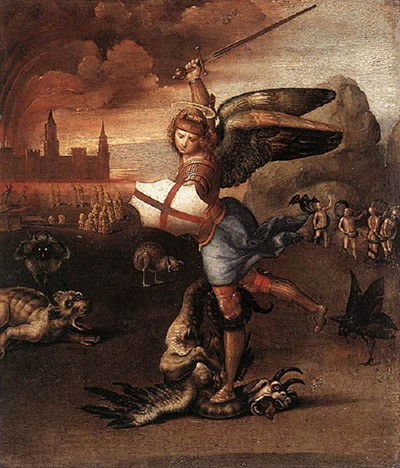The St Michael painting by Raphael is widely recognized by many people. Although most individuals know the appearance of the painting, they do not know the real story behind it.
The beautiful painting contains an image of Archangel Michael with several demons around him. Michael has a halo and wings attached to his body, and he is surrounded by depths of hell that are dreary and dark. There are several demons on the ground around him and underneath his foot. St Michael has a long sword and a shield for fighting all demon sufferers around him. Also, there are angels in the painting, and all the demons behind him are in suffering. It was completed in the years 1504 to 1505 on a draught board, and it was commissioned by the Louse XII of France. The painting is currently housed in Louvre, Paris and it represents the early work of Raphael on the martial subjects.
In this painting, Raphael used oil paints that were popular in Italy. Most of his work was executed on a panel. In most artistic works he experimented with the oil paints to achieve the excellent depth of shadow and the richer colours related to the oil medium. Before settling in Rome, all of his artistic work was designed and executed in Italian oil. In most cases, he painted on a piece of paper or vellum. After painting on several pieces of paper, he glued them together to obtain the image. The main medium used in this painting was a certain type of gouache in which the pigment used was bound with glue. While working on the St Michael painting, he employed various assistants, and he only intervened in some stages including intermediary, preliminary and the final. It is also believed that he interested himself in the central and marginal parts.
Most of his oil painting styles developed because of the contact with a Venetian painting in Rome. He used light and colour as his pictorial elements that were independent of the form and line. The range of the impasto in some of his paintings has a few parallels in the artistic work of his masters. More changes in his painting styles and techniques may be observed in his drawings upon his relocation to Rome. There is also a gradual abandonment of metal points in favour of chalk and the use of a new medium of light red chalk in the painting. Despite all the changes, his methods and painting styles as an artist were remarkably consistent.
The painting represents the Apocalypse of St John, the Archangel Michael, who was overcoming an allegorical embodiment of the evil and the rebel angels. From the painting, it is clear that he casts them to earth. In the depiction, Raphael had an opportunity to enrich the scene’s traditional representations with the ancillary sites inspired by Inferno in the famous Devine Comedy in which he recounts the punishment of the hypocrites and thieves.




